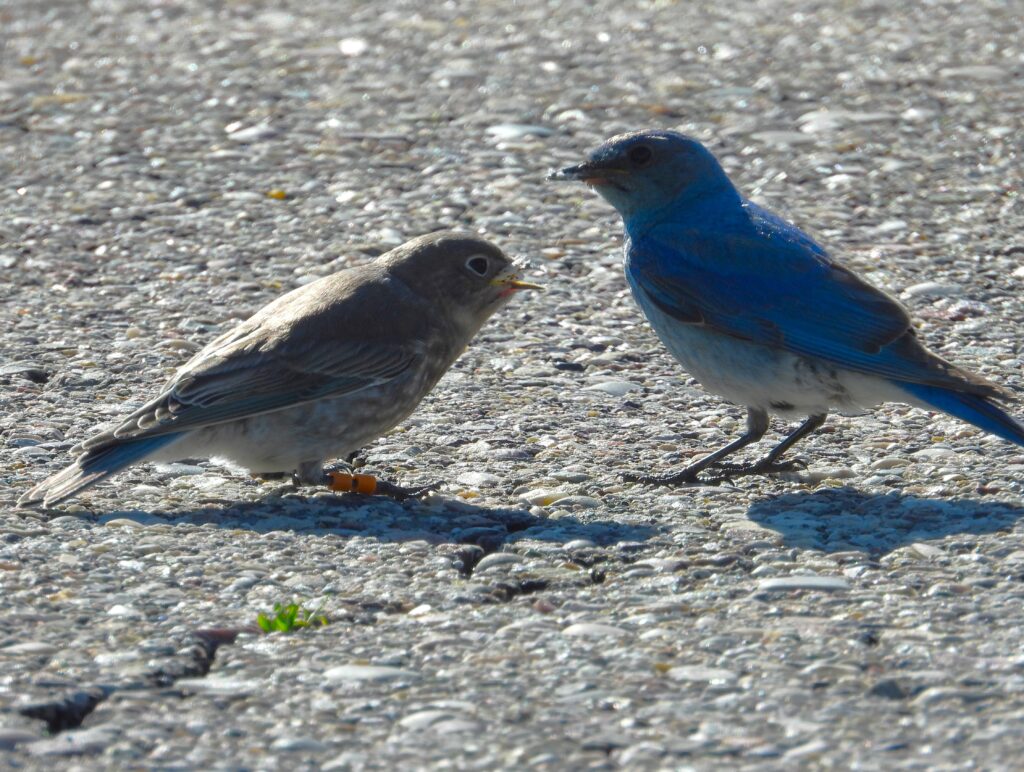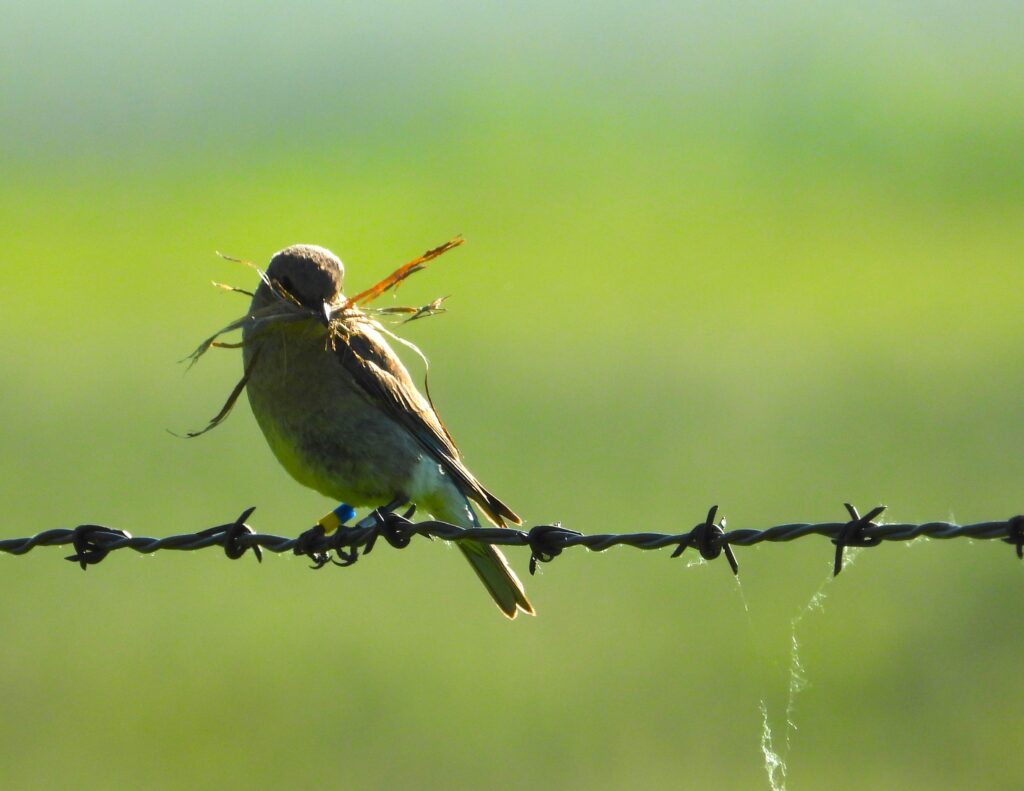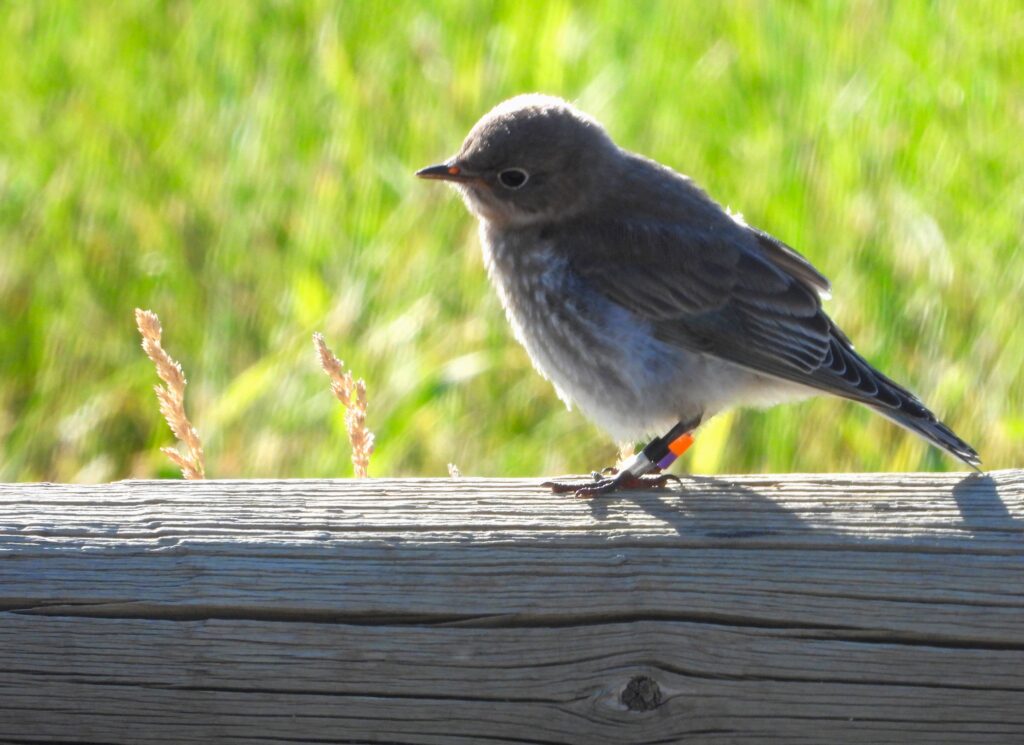By Kyle and Vicki
What purpose does our nestbox trail serve?
Mountain bluebirds are a cavity nesting species which rely mainly on holes in trees, often created by woodpeckers, to raise their young. This species of bluebird is believed to be on the decline in the West due to factors such as habitat loss and competition for limited cavity nests from invasive species like house sparrows and European starlings.

A fledgling bluebird from box 44 is fed by an adult on Monday at the Fish Hatchery. Photo Vicki Morgan.
Mountain bluebirds are among the first nesting songbirds to return to the Jackson Hole area each spring. There is likely some evolutionary strategy at play here; by returning when the ground is largely still snow covered bluebirds risk exposure to lack of food and cold temperatures, but gain an advantage over rival species when it comes to snagging limited nesting sites.
Our trail of volunteer-built nestboxes on the National Elk Refuge’s western boundary not only provides bluebirds with much needed nesting locations, but allows scientists a chance to gain a more complete understanding of the overall health of this sub-population.
How are the bluebirds faring this spring?
Overall, we’re confident 2023 has been a good year for bluebirds. While we won’t have a full dataset until the end of the summer, reports from our banding team and volunteers indicate bluebirds both returned to the trail and nested in relatively high numbers this spring.

While spring conditions imperiled some nestlings early in the season, wet conditions are likely to foster increased numbers of insects later in the summer which may benefit second rounds of nests. Photo: Vicki Morgan.
At one point, 16 active nests were recorded, more than were active over the entirety of last season. According to Lead Bird Bander Vicki Morgan, who surveys boxes and organizes volunteer data weekly, there are currently two to three boxes with nestlings about to fledge, and between four and six boxes where bluebirds are on their second attempts at nest building.
Several fledglings from box 44 were even “hanging out” at the Fish Hatchery parking lot, where they were being fed by their parents as of Monday morning (don’t all go to photograph them at once!).
The success of nestboxes this year can at least partially be attributed to last year’s batch of fledglings. At least four nest boxes contain female bluebirds which were banded last year as chicks. These birds migrated away last winter and have since completed successful return journeys back to the National Elk Refuge to build their own nests, usually within hundreds of meters from where they themselves hatched. The fancy phrase for this is “site fidelity.”
What are the challenges facing this year’s nesters?
Still, bluebirds on the nest box trail have faced challenges in 2023. While nest building jumped off to a quick start, insects were slow to emerge due to late-spring weather patterns and a handful of nests failed with a lack of available food for nestlings. While nest failure is a natural and normal process, it doesn’t mean it can’t be frustrating to witness young birds not make it, especially when you’re rooting for team bluebird! Several of our boxes have also experienced predation in recent weeks. Our best guess is that weasels are the culprit – snakes can also fit through nest box holes but generally devour young birds whole. Weasels on the other hand are prone to leaving behind “nestling bits” as evidence of their transgressions.

A 2023 fledgling with this year’s diagnostic color-band combination. Photo: Vicki Morgan
Are the nestboxes helpful for the birds?
We believe they are. Although not all nestling birds survive (you’re welcome weasels – for the buffet), the fact that many bluebirds do successfully fledge indicates the Mountain Bluebird Nestbox Project is likely having a net positive effect. Two years ago, a bird banded on our trail was recaptured and released in Texas during winter migration. And each year more and more “resights” of birds banded in previous years pour in. It’s going to take more than one productive year to help ensure the longevity of this species in our region, but that doesn’t mean we can’t get excited about this season’s results!
